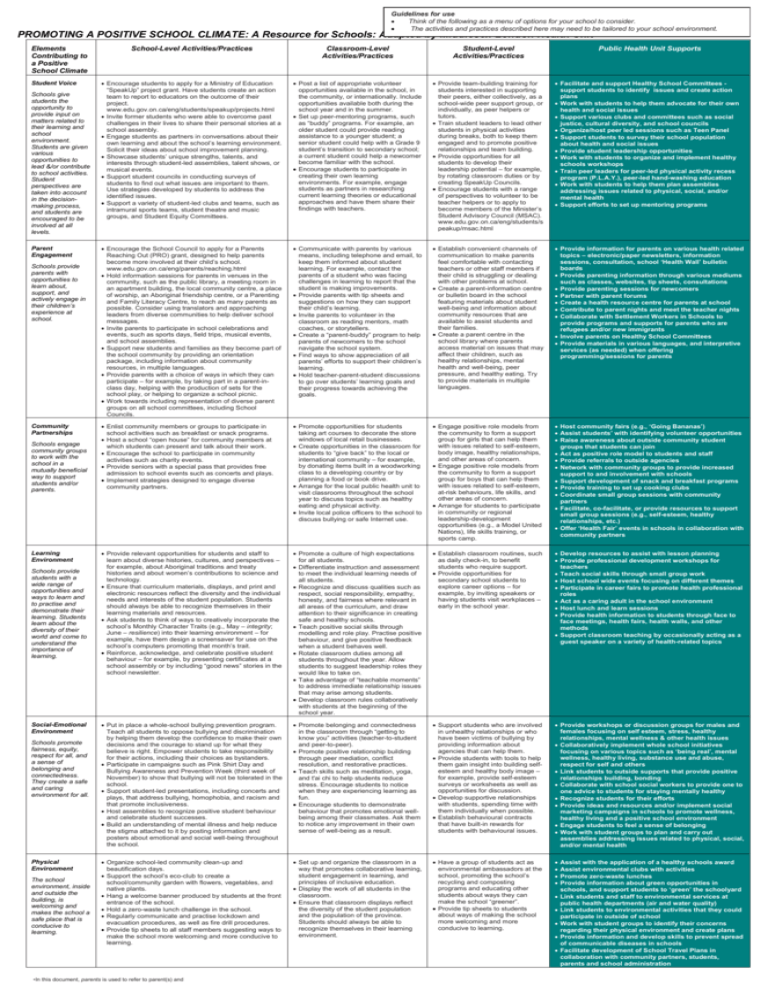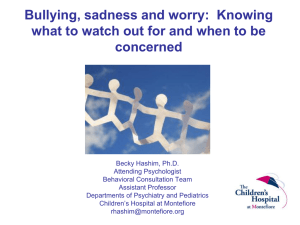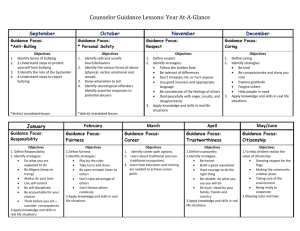promoting a positive school climate
advertisement

Guidelines for use Think of the following as a menu of options for your school to consider. The activities and practices described here may need to be tailored to your school environment. PROMOTING A POSITIVE SCHOOL CLIMATE: A Resource for Schools: Adapted by Middlesex-London Health Unit Elements Contributing to a Positive School Climate Student Voice Schools give students the opportunity to provide input on matters related to their learning and school environment. Students are given various opportunities to lead &/or contribute to school activities. Student perspectives are taken into account in the decisionmaking process, and students are encouraged to be involved at all levels. Parent Engagement Schools provide parents with opportunities to learn about, support, and actively engage in their children’s experience at school. Community Partnerships Schools engage community groups to work with the school in a mutually beneficial way to support students and/or parents. Learning Environment Schools provide students with a wide range of opportunities and ways to learn and to practise and demonstrate their learning. Students learn about the diversity of their world and come to understand the importance of learning. Social-Emotional Environment Schools promote fairness, equity, respect for all, and a sense of belonging and connectedness. They create a safe and caring environment for all. Physical Environment The school environment, inside and outside the building, is welcoming and makes the school a safe place that is conducive to learning. School-Level Activities/Practices Classroom-Level Activities/Practices Student-Level Activities/Practices Public Health Unit Supports Encourage students to apply for a Ministry of Education “SpeakUp” project grant. Have students create an action team to report to educators on the outcome of their project. www.edu.gov.on.ca/eng/students/speakup/projects.html Invite former students who were able to overcome past challenges in their lives to share their personal stories at a school assembly. Engage students as partners in conversations about their own learning and about the school’s learning environment. Solicit their ideas about school improvement planning. Showcase students’ unique strengths, talents, and interests through student-led assemblies, talent shows, or musical events. Support student councils in conducting surveys of students to find out what issues are important to them. Use strategies developed by students to address the identified issues. Support a variety of student-led clubs and teams, such as intramural sports teams, student theatre and music groups, and Student Equity Committees. Post a list of appropriate volunteer opportunities available in the school, in the community, or internationally. Include opportunities available both during the school year and in the summer. Set up peer-mentoring programs, such as “buddy” programs. For example, an older student could provide reading assistance to a younger student; a senior student could help with a Grade 9 student’s transition to secondary school; a current student could help a newcomer become familiar with the school. Encourage students to participate in creating their own learning environments. For example, engage students as partners in researching current learning theories or educational approaches and have them share their findings with teachers. Provide team-building training for students interested in supporting their peers, either collectively, as a school-wide peer support group, or individually, as peer helpers or tutors. Train student leaders to lead other students in physical activities during breaks, both to keep them engaged and to promote positive relationships and team building. Provide opportunities for all students to develop their leadership potential – for example, by rotating classroom duties or by creating SpeakUp Councils. Encourage students with a range of perspectives to volunteer to be teacher helpers or to apply to become members of the Minister’s Student Advisory Council (MSAC). www.edu.gov.on.ca/eng/students/s peakup/msac.html Facilitate and support Healthy School Committees support students to identify issues and create action plans Work with students to help them advocate for their own health and social issues Support various clubs and committees such as social justice, cultural diversity, and school councils Organize/host peer led sessions such as Teen Panel Support students to survey their school population about health and social issues Provide student leadership opportunities Work with students to organize and implement healthy schools workshops Train peer leaders for peer-led physical activity recess program (P.L.A.Y.), peer-led hand-washing education Work with students to help them plan assemblies addressing issues related to physical, social, and/or mental health Support efforts to set up mentoring programs Encourage the School Council to apply for a Parents Reaching Out (PRO) grant, designed to help parents become more involved at their child’s school. www.edu.gov.on.ca/eng/parents/reaching.html Hold information sessions for parents in venues in the community, such as the public library, a meeting room in an apartment building, the local community centre, a place of worship, an Aboriginal friendship centre, or a Parenting and Family Literacy Centre, to reach as many parents as possible. Consider using translators and approaching leaders from diverse communities to help deliver school messages. Invite parents to participate in school celebrations and events, such as sports days, field trips, musical events, and school assemblies. Support new students and families as they become part of the school community by providing an orientation package, including information about community resources, in multiple languages. Provide parents with a choice of ways in which they can participate – for example, by taking part in a parent-inclass day, helping with the production of sets for the school play, or helping to organize a school picnic. Work towards including representation of diverse parent groups on all school committees, including School Councils. Communicate with parents by various means, including telephone and email, to keep them informed about student learning. For example, contact the parents of a student who was facing challenges in learning to report that the student is making improvements. Provide parents with tip sheets and suggestions on how they can support their child’s learning. Invite parents to volunteer in the classroom as reading mentors, math coaches, or storytellers. Create a “parent-buddy” program to help parents of newcomers to the school navigate the school system. Find ways to show appreciation of all parents’ efforts to support their children’s learning. Hold teacher-parent-student discussions to go over students’ learning goals and their progress towards achieving the goals. Establish convenient channels of communication to make parents feel comfortable with contacting teachers or other staff members if their child is struggling or dealing with other problems at school. Create a parent-information centre or bulletin board in the school featuring materials about student well-being and information about community resources that are available to assist students and their families. Create a parent centre in the school library where parents access material on issues that may affect their children, such as healthy relationships, mental health and well-being, peer pressure, and healthy eating. Try to provide materials in multiple languages. Provide information for parents on various health related topics – electronic/paper newsletters, information sessions, consultation, school ‘Health Wall’ bulletin boards Provide parenting information through various mediums such as classes, websites, tip sheets, consultations Provide parenting sessions for newcomers Partner with parent forums Create a health resource centre for parents at school Contribute to parent nights and meet the teacher nights Collaborate with Settlement Workers in Schools to provide programs and supports for parents who are refugees and/or new immigrants Involve parents on Healthy School Committees Provide materials in various languages, and interpretive services (as needed) when offering programming/sessions for parents Enlist community members or groups to participate in school activities such as breakfast or snack programs. Host a school “open house” for community members at which students can present and talk about their work. Encourage the school to participate in community activities such as charity events. Provide seniors with a special pass that provides free admission to school events such as concerts and plays. Implement strategies designed to engage diverse community partners. Promote opportunities for students taking art courses to decorate the store windows of local retail businesses. Create opportunities in the classroom for students to “give back” to the local or international community – for example, by donating items built in a woodworking class to a developing country or by planning a food or book drive. Arrange for the local public health unit to visit classrooms throughout the school year to discuss topics such as healthy eating and physical activity. Invite local police officers to the school to discuss bullying or safe Internet use. Engage positive role models from the community to form a support group for girls that can help them with issues related to self-esteem, body image, healthy relationships, and other areas of concern. Engage positive role models from the community to form a support group for boys that can help them with issues related to self-esteem, at-risk behaviours, life skills, and other areas of concern. Arrange for students to participate in community or regional leadership-development opportunities (e.g., a Model United Nations), life skills training, or sports camp. Host community fairs (e.g., ‘Going Bananas’) Assist students’ with identifying volunteer opportunities Raise awareness about outside community student groups that students can join Act as positive role model to students and staff Provide referrals to outside agencies Network with community groups to provide increased support to and involvement with schools Support development of snack and breakfast programs Provide training to set up cooking clubs Coordinate small group sessions with community partners Facilitate, co-facilitate, or provide resources to support small group sessions (e.g., self-esteem, healthy relationships, etc.) Offer ‘Health Fair’ events in schools in collaboration with community partners Provide relevant opportunities for students and staff to learn about diverse histories, cultures, and perspectives – for example, about Aboriginal traditions and treaty histories and about women’s contributions to science and technology. Ensure that curriculum materials, displays, and print and electronic resources reflect the diversity and the individual needs and interests of the student population. Students should always be able to recognize themselves in their learning materials and resources. Ask students to think of ways to creatively incorporate the school’s Monthly Character Traits (e.g., May – integrity; June – resilience) into their learning environment – for example, have them design a screensaver for use on the school’s computers promoting that month’s trait. Reinforce, acknowledge, and celebrate positive student behaviour – for example, by presenting certificates at a school assembly or by including “good news” stories in the school newsletter. Promote a culture of high expectations for all students. Differentiate instruction and assessment to meet the individual learning needs of all students. Recognize and discuss qualities such as respect, social responsibility, empathy, honesty, and fairness where relevant in all areas of the curriculum, and draw attention to their significance in creating safe and healthy schools. Teach positive social skills through modelling and role play. Practise positive behaviour, and give positive feedback when a student behaves well. Rotate classroom duties among all students throughout the year. Allow students to suggest leadership roles they would like to take on. Take advantage of “teachable moments” to address immediate relationship issues that may arise among students. Develop classroom rules collaboratively with students at the beginning of the school year. Establish classroom routines, such as daily check-in, to benefit students who require support. Provide opportunities for secondary school students to explore career options – for example, by inviting speakers or having students visit workplaces – early in the school year. Develop resources to assist with lesson planning Provide professional development workshops for teachers Teach social skills through small group work Host school wide events focusing on different themes Participate in career fairs to promote health professional roles Act as a caring adult in the school environment Host lunch and learn sessions Provide health information to students through face to face meetings, health fairs, health walls, and other methods Support classroom teaching by occasionally acting as a guest speaker on a variety of health-related topics Put in place a whole-school bullying prevention program. Teach all students to oppose bullying and discrimination by helping them develop the confidence to make their own decisions and the courage to stand up for what they believe is right. Empower students to take responsibility for their actions, including their choices as bystanders. Participate in campaigns such as Pink Shirt Day and Bullying Awareness and Prevention Week (third week of November) to show that bullying will not be tolerated in the school. Support student-led presentations, including concerts and plays, that address bullying, homophobia, and racism and that promote inclusiveness. Host assemblies to recognize positive student behaviour and celebrate student successes. Build an understanding of mental illness and help reduce the stigma attached to it by posting information and posters about emotional and social well-being throughout the school. Promote belonging and connectedness in the classroom through “getting to know you” activities (teacher-to-student and peer-to-peer). Promote positive relationship building through peer mediation, conflict resolution, and restorative practices. Teach skills such as meditation, yoga, and t'ai chi to help students reduce stress. Encourage students to notice when they are experiencing learning as fun. Encourage students to demonstrate behaviour that promotes emotional wellbeing among their classmates. Ask them to notice any improvement in their own sense of well-being as a result. Support students who are involved in unhealthy relationships or who have been victims of bullying by providing information about agencies that can help them. Provide students with tools to help them gain insight into building selfesteem and healthy body image – for example, provide self-esteem surveys or worksheets as well as opportunities for discussion. Develop supportive relationships with students, spending time with them individually when possible. Establish behavioural contracts that have built-in rewards for students with behavioural issues. Provide workshops or discussion groups for males and females focusing on self esteem, stress, healthy relationships, mental wellness & other health issues Collaboratively implement whole school initiatives focusing on various topics such as ‘being real’, mental wellness, healthy living, substance use and abuse, respect for self and others Link students to outside supports that provide positive relationships building, bonding Collaborate with school social workers to provide one to one advice to students for staying mentally healthy Recognize students for their efforts Provide ideas and resources and/or implement social marketing campaigns in schools to promote wellness, healthy living and a positive school environment Engage students to feel a sense of belonging Work with student groups to plan and carry out assemblies addressing issues related to physical, social, and/or mental health Organize school-led community clean-up and beautification days. Support the school’s eco-club to create a school/community garden with flowers, vegetables, and native plants. Hang a welcome banner produced by students at the front entrance of the school. Hold a zero-waste lunch challenge in the school. Regularly communicate and practise lockdown and evacuation procedures, as well as fire drill procedures. Provide tip sheets to all staff members suggesting ways to make the school more welcoming and more conducive to learning. Set up and organize the classroom in a way that promotes collaborative learning, student engagement in learning, and principles of inclusive education. Display the work of all students in the classroom. Ensure that classroom displays reflect the diversity of the student population and the population of the province. Students should always be able to recognize themselves in their learning environment. Have a group of students act as environmental ambassadors at the school, promoting the school’s recycling and composting programs and educating other students about ways they can make the school “greener”. Provide tip sheets to students about ways of making the school more welcoming and more conducive to learning. ∗In this document, parents is used to refer to parent(s) and guardian(s). Assist with the application of a healthy schools award Assist environmental clubs with activities Promote zero-waste lunches Provide information about green opportunities in schools, and support students to ‘green’ the schoolyard Link students and staff to environmental services at public health departments (air and water quality) Link students to environmental activities that they could participate in outside of school Work with student groups to identify their concerns regarding their physical environment and create plans Provide information and develop skills to prevent spread of communicable diseases in schools Facilitate development of School Travel Plans in collaboration with community partners, students, parents and school administration







